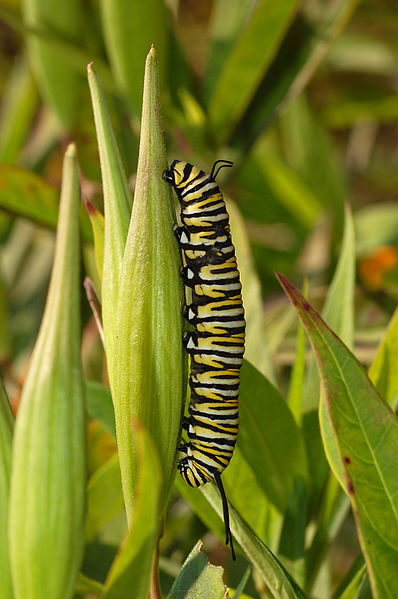Chemical ecology is the study of chemically mediated interactions between living organisms, and the effects of those interactions on the demography, behavior and ultimately evolution of the organisms involved. It is thus a vast and highly interdisciplinary field. Chemical ecologists seek to identify the specific molecules that function as signals mediating community or ecosystem processes and to understand the evolution of these signals. The substances that serve in such roles are typically small, readily-diffusible organic molecules, but can also include larger molecules and small peptides.
Monarch butterfly caterpillar on milkweed plant.
Zoanthus sociatus produces palytoxin
American lobster (Homarus americanus)
Pheromone trap used to catch the pest Lymantria monacha.
Chemical defense is a strategy employed by many organisms to avoid consumption by producing toxic or repellent metabolites or chemical warnings which incite defensive behavioral changes. The production of defensive chemicals occurs in plants, fungi, and bacteria, as well as invertebrate and vertebrate animals. The class of chemicals produced by organisms that are considered defensive may be considered in a strict sense to only apply to those aiding an organism in escaping herbivory or predation. However, the distinction between types of chemical interaction is subjective and defensive chemicals may also be considered to protect against reduced fitness by pests, parasites, and competitors. Repellent rather than toxic metabolites are allomones, a sub category signaling metabolites known as semiochemicals. Many chemicals used for defensive purposes are secondary metabolites derived from primary metabolites which serve a physiological purpose in the organism. Secondary metabolites produced by plants are consumed and sequestered by a variety of arthropods and, in turn, toxins found in some amphibians, snakes, and even birds can be traced back to arthropod prey. There are a variety of special cases for considering mammalian antipredatory adaptations as chemical defenses as well.

Monarch butterfly caterpillar on milkweed plant. Milkweeds use three primary defenses to limit damage caused by caterpillars: hairs on the leaves, cardenolide toxins, and latex fluids, but Monarchs have evolved to remain unaffected by these defenses. Cardenolide toxins sequestered during the Monarch's larval stage from feeding on the plant remains in the adult, making it unpalatable to predators.
The fungus Penicillium chrysogenum. It produces penicillin, a compound which kills bacteria.
A spicule found on the surface of a sponge. Sponges who produce more secondary metabolites produce fewer spicules.
Sea hares employ phagomimicry as a form of chemical defense.







